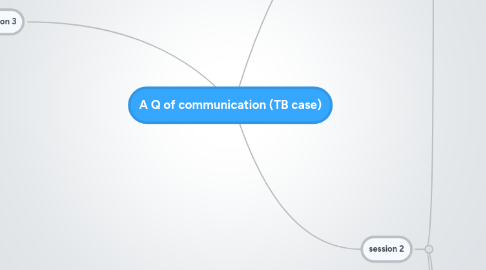
1. session 3
1.1. Step 9
1.1.1. Review session 3
1.1.2. visualize the data and theory
1.1.2.1. mycobacterial TB
1.1.2.2. sensitive to rifampicine , isoneside, ethanbutol
1.1.3. 20 minutes
1.2. Step 10
1.2.1. Management (for the individual)
1.2.2. based on:
1.2.2.1. patient's problem list
1.2.2.2. treatment
1.2.2.2.1. initial treatment
1.2.2.2.2. continuation phase
1.2.2.2.3. should in combination
1.2.2.2.4. DOTS for at least two months
1.2.2.2.5. combination of drugs to avoid resistance
1.2.2.2.6. if the result after two months positive and the initial x-ray has cavities it extends the continuation phase for nine months
1.2.2.2.7. three drugs should be resistance to call it resistance
1.2.2.2.8. with second line treatment : the cost is high
1.2.2.2.9. streptomycine for old people
1.2.2.2.10. surgical is needed if there is multidrug resistance, but not preferable
1.2.2.2.11. regular chick urine to make sure that he is taking his drug
1.2.2.3. options
1.2.2.3.1. first line
1.2.2.4. regime
1.2.2.4.1. once daily or twice a week
1.2.2.4.2. if its fully sensative no need to ethabutol
1.2.2.4.3. in extra pulmonary more time is needed
1.2.2.4.4. multidrug resistance for at least 18 months
1.2.2.4.5. if it is not effective either elongate or restart
1.2.2.5. qualifying factors
1.2.2.6. evidence
1.2.3. Prevention (for the population)
1.2.3.1. isolation
1.2.3.2. BCG vaccination
1.2.3.2.1. recommended for children
1.2.3.2.2. most neonatal take it
1.2.3.2.3. recommended in areas that have high TB incidence
1.2.3.3. opens windows
1.2.3.4. protective measures for people close to TB patient
1.2.3.5. finishing the entire medication course
1.2.3.6. high risk for children under thae age of 4 years
1.2.3.7. hospital policy
1.2.3.8. check co-workers and close contact
1.2.3.9. educate the patient about his disease capabilities
1.2.4. 60 minutes
1.3. step 11
1.3.1. Review and evaluate
1.3.2. Chairman
1.3.3. Scribe
1.3.4. Tutor
1.3.5. members
1.3.6. Material
1.3.7. 10 minutes
2. session 1
2.1. Step 1
2.1.1. Identify terms and cues
2.1.2. New terms
2.1.2.1. jenitor
2.1.2.2. phlegm
2.1.3. cues
2.1.3.1. male
2.1.3.2. mid-30
2.1.3.3. coughing phlegm and blood associated
2.1.3.4. course of antibiotics
2.1.3.5. sweat at night
2.1.3.6. came from indonesia seven years ago
2.1.3.7. janitor in a hospital for the last two years
2.1.3.8. two months and half without treatment
2.1.3.9. living with family
2.1.3.10. wight loss 5KG
2.1.3.11. absent from work
2.1.3.12. lives in mecca
2.1.4. 10 minutes
2.2. Step 2
2.2.1. Problem formulation (put it in a sentence)
2.2.1.1. a male in his mid-30s started coughing phlegm and couple of time with blood, night sweat and 5Kg wight loss three months ago. He was treated with amoxicillin two weeks ago with no improvement
2.2.2. 10 minutes
2.3. Step 3
2.3.1. Hypothesis generation (brainstorming)
2.3.1.1. lung cancer
2.3.1.2. epiglotts infection
2.3.1.3. TB
2.3.1.3.1. hospital acquired
2.3.1.3.2. country of origin
2.3.1.4. pnuemonia
2.3.1.5. pulmonary infection
2.3.1.6. hospital acquired infection
2.3.1.7. viral infection
2.3.1.8. STD
2.3.1.9. oral cancer
2.3.1.10. pulmonary fibrosis
2.3.1.11. cystic fibrosis
2.3.1.12. hepatitis
2.3.1.13. pericarditis
2.3.1.14. GIT infection
2.3.1.15. gastric cancer
2.3.1.16. hyperthyroidism
2.3.1.17. bronchitis
2.3.1.18. upper respiratory track infection
2.3.1.19. autoimmune disease
2.3.1.20. pluritis
2.3.1.21. allergies
2.3.1.22. immune compromised
2.3.1.23. poisoning
2.3.1.24. flu
2.3.1.25. esophageal hernia
2.3.1.26. tonsillitis
2.3.1.27. drug abuse
2.3.1.28. drug complications
2.3.2. 40 minutes
2.4. Step 4
2.4.1. Hypothesis organization (tentative solution)
2.4.1.1. infection
2.4.1.1.1. upper respiratory track infection
2.4.1.1.2. TB
2.4.1.1.3. bronchitis
2.4.1.1.4. pnuemonia
2.4.1.1.5. epiglotts infection
2.4.1.2. malignancies
2.4.1.2.1. lung cancer
2.4.2. 20 minutes
3. session 2
3.1. Step 6
3.1.1. Review session 1
3.1.1.1. Summary of step 5
3.1.1.1.1. Step 5
3.1.2. Report new knowledge
3.1.2.1. Anatomy
3.1.2.1.1. genral
3.1.2.1.2. lung
3.1.2.2. Pathophysiology
3.1.2.2.1. cough reflex
3.1.2.2.2. night sweat
3.1.2.2.3. phlegm
3.1.2.2.4. weight loss
3.1.2.2.5. bloody phlegm
3.1.2.2.6. what is the difference between cystic fibrosis and pulmonary fibrosis?
3.1.2.3. Patholog
3.1.2.3.1. TB
3.1.2.3.2. pnuemonia
3.1.2.3.3. lung cancer
3.1.3. 30 minutes
3.2. Step 7
3.2.1. Inquiry plan and info gathering
3.2.1.1. history
3.2.1.1.1. risk factors?
3.2.1.1.2. history of present illness
3.2.1.1.3. past history
3.2.1.1.4. family history
3.2.1.1.5. social
3.2.1.2. examination
3.2.1.2.1. hand
3.2.1.2.2. no lymph node evlargment
3.2.1.2.3. no liver or spleen enlargement
3.2.1.2.4. plural expansion normal
3.2.1.2.5. percussion : reasoning
3.2.1.3. tests results
3.2.1.3.1. X-ray
3.2.1.3.2. sputum
3.2.1.3.3. CBC
3.2.1.3.4. sensitivity : mycobacterial TB sensitive to: INH, rifampin, and ethambutol
3.2.1.3.5. PPD
3.2.2. 40 minutes
3.3. Step 8
3.3.1. Diagnostic decision
3.3.1.1. mycobacterum tuberculosis infection
3.3.2. Mechanism
3.3.2.1. the bacteria enters the body
3.3.2.2. activate the macrophage
3.3.2.3. then activated the T cell helper 1 which eventually cause caseous necrosis
3.3.3. Presentation
3.3.3.1. cough with phlegm and blood
3.3.3.2. night sweat
3.3.3.3. weight loss
3.3.3.4. fatique
3.3.4. Supporting data
3.3.4.1. X-ray
3.3.4.1.1. marked plural thickening in right upper lobe (consolidation)
3.3.4.2. sputum
3.3.4.2.1. acid fast bacilli positive three times
3.3.4.2.2. mycobacteria identify
3.3.4.3. PPD
3.3.4.3.1. 16 high
3.3.5. 10 minutes
3.3.6. PICO
3.3.6.1. in middle age TB patient is methacilin better for the treatment of Tb rather than rifampicine?
3.3.6.2. in middle age TB pateint does amoxiciline help in decrease the mycobacteria in comparision to no treatment
